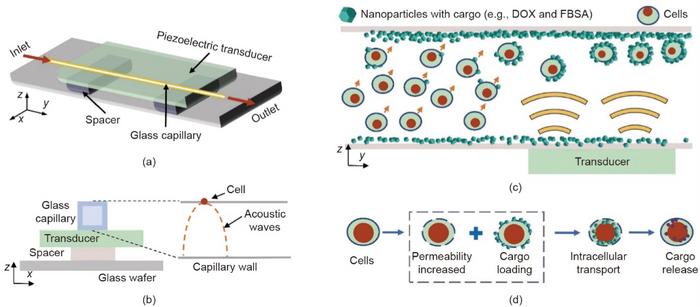A recent groundbreaking study in the journal Engineering has unveiled a revolutionary method for intracellular delivery of nanoparticles, leveraging the principles of acoustofluidics. This innovative approach propels the possibilities for transporting a diverse range of functional nanomaterials into varying cell types, with implications that could transform therapeutic strategies and advancements in biophysical research. The efficient delivery of biomolecular cargos into cells is a critical component in the realm of biomedical research, particularly for fields encompassing gene therapies and targeted drug delivery.
Traditional methodologies for intracellular delivery, such as the endocytosis of nano-vectors, microinjection, and electroporation, have been hindered by inherent limitations. These conventional processes often involve time-intensive protocols, complex operational steps, and require the use of expensive equipment. Furthermore, they grapple with challenges like low delivery efficiency and potential cytotoxicity that could damage the very cells these techniques aim to treat. Therefore, the advent of a new delivery mechanism that overcomes these obstacles is both timely and crucial.
The acoustofluidics-based method described in this recent study exploits the interaction between standing acoustic waves and cargo-encapsulated nanoparticles within a glass capillary. When cells pass through the capillary, these acoustic waves act to push them toward the capillary wall, fostering a highly controllable environment for interaction between the cells and the encapsulated nanoparticles. This interaction is pivotal as it significantly increases the likelihood of nanoparticle attachment to the cell membrane, leading to enhanced uptake by the cells.
In the study, the efficacy of this acoustofluidics-based method was tested using two distinct types of cargos: doxorubicin (DOX), a well-known chemotherapeutic agent, and fluorescein isothiocyanate (FITC)-labeled bovine serum albumin (FBSA), a model protein often used in research. Both cargo types were loaded into zeolitic imidazolate framework-8 (ZIF-8) nanoparticles, a versatile nanomaterial known for its favorable properties. Results indicated a remarkable increase in the delivery efficiency of these nanoparticles into human U937 and HeLa cell lines, in stark contrast to delivery methods that did not incorporate the use of acoustofluidics.
Further exploration into the mechanics of this innovative delivery mechanism revealed that the acoustic radiation force plays a crucial role in increasing membrane stress during the delivery process. This stress slightly deforms the cells, consequently enhancing the permeability of their membranes. The consequent deformation is not detrimental; rather, it facilitates an efficient passage for nanoparticles to enter the cells, which is a significant advantage over existing delivery techniques.
Moreover, the research team has expressed ambitions to extend this method’s applicability to various types of cargo, not limited to DOX and FBSA. Future studies will aim to investigate the delivery efficiency of this acoustofluidics-based approach with other therapeutic agents, broadening its potential applications. There are also plans to explore its efficacy in delivering drugs to primary human cells, potentially broadening the therapeutic reach of this innovative method.
The implications of this study are far-reaching, promising a novel approach for achieving both efficient and controllable delivery of biomolecular cargos to target cells. The prospective advantages of using this technology pave the way for accelerating advancements in gene and cellular therapies, as well as providing new avenues for research into fundamental aspects of cell mechanics. The ability of this method to enhance nanoparticle delivery presents a significant leap forward, with potential benefits that could ripple across various fields of medicine and biotechnology.
Overall, this acoustofluidics-based approach signifies a paradigm shift in how we think about and execute intracellular deliveries, providing a more efficient, safer method for cellular transport of therapeutic agents. As the study’s authors emphasize, the findings could significantly influence the path of future biomedical research, leading to innovative treatment strategies that maximize the efficacy while minimizing the risks associated with cellular delivery processes.
In summary, the acoustofluidics-based intracellular nanoparticle delivery offers an exciting glimpse into the future of biomedical applications, merging cutting-edge technology with practical utility. As researchers continue to refine and expand upon these findings, we may soon witness transformative changes in therapeutic methodologies and enhanced capabilities in the delivery of biomedical agents to cells.
Subject of Research: Acoustofluidics-based intracellular nanoparticle delivery
Article Title: Acoustofluidics-Based Intracellular Nanoparticle Delivery
News Publication Date: 14-Dec-2024
Web References: DOI Link
References: Zhishang Li et al.
Image Credits: Zhishang Li et al.
Keywords
Acoustofluidics, intracellular delivery, nanoparticles, drug delivery systems, biomedical research, gene therapies, cell mechanics.
Tags: acoustic wave interactions in cellsacoustofluidics technologybiophysical research techniquescell treatment methodologiesefficient biomolecular transportgene therapy advancementsinnovative drug delivery methodsintracellular nanoparticle deliverynanomaterials in medicineovercoming delivery limitationstargeted drug delivery systemstherapeutic strategies for cells





